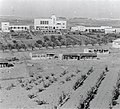Ayanot
Ayanot
| |
|---|---|
 | |
| Etymology: Springs | |
| Coordinates: 31°54′56.88″N 34°46′5.15″E / 31.9158000°N 34.7680972°E | |
| Country | |
| District | Central |
| Council | Gan Raveh |
| Founded | 30 March 1930–12 January 1932 |
| Founded by | Ada Maimon |
| Population (2022)[1] | 342 |
| Website | ayanot.org.il |
Ayanot (Template:Lang-he-n, lit. Fountains) is a youth village in central Israel. Located near Ness Ziona, it falls under the jurisdiction of Gan Raveh Regional Council. In 2022 it had a population of 342.[1]
History

The foundation of the village began with the purchase of 140 acres (0.57 km2) of land by Ada Maimon as a girl's training farm [2] in 1926. The village was established on 30 March 1930, though no-one lived on the site until Maimon, ten girls and a guard moved in on 12 January 1932; until then they had lived in nearby Ness Ziona. The village was named after the numerous springs in the area, though other sources claim it is taken from Deuteronomy 8:7;
For the LORD thy God bringeth thee into a good land, a land of brooks of water, of fountains and depths, springing forth in valleys and hills.[3]
-
Ayanot 1941 1:20,000
-
Ayanot1945 1:250,000
-
Ayanot 1930
The Jewish National Fund wrote in 1949 that the name is derived from the Arabic.[2]
During World War II, the village became an agricultural school and took in young Holocaust survivors who had succeeded in immigrating. Today it is home to a boarding school for 180 pupils. A few years ago, the agricultural school opened a miniature horse farm and one of its horses was a runner-up in the 2008 world championship for miniature horses.[4]
In 2010, the village celebrated its 80th anniversary.[4]
References
- ^ a b "Regional Statistics". Israel Central Bureau of Statistics. Retrieved 21 March 2024.
- ^ a b Jewish National Fund (1949). Jewish Villages in Israel. Jerusalem: Hamadpis Liphshitz Press. p. 9.
- ^ "Deuteronomy Chapter 8". Mechon Mamre.
- ^ a b Noah Kosharek (4 March 2010). "Runner-up in mini-horse tourney becomes a first-time father". Haaretz. Retrieved 27 January 2014.





